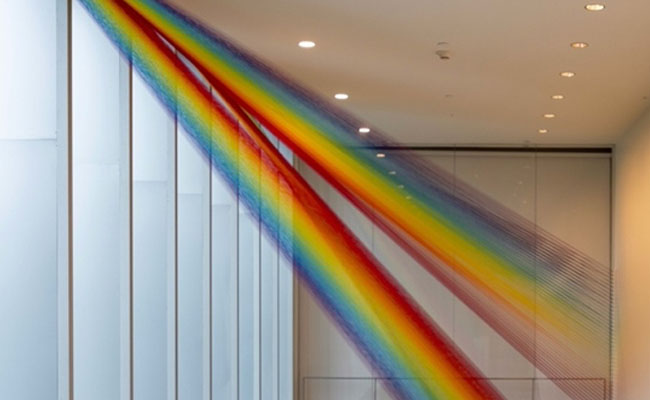SITE-SPECIFIC INSTALLATION AT MUSEUM

A stunning and recognizable symbol of the Bruce Museum in Greenwich is now part of the permanent collection. The museum recently acquired “Plexus no. 43,” an immersive, site-specific installation by renowned artist Gabriel Dawe. Commissioned by the museum in 2022 and originally on loan for a three-year period, this vibrant work was unveiled at the opening of the Bruce’s new, state-of-the-art building in April 2023 and quickly became a popular feature and landmark of the museum.
“Plexus no. 43” is composed of over eight miles of meticulously arranged colored threads and creates a mesmerizing visual effect that transforms the space above the museum’s Heidi Brake Smith and Scott M. Smith Gallery Stair and Balcony. The installation welcomes visitors to the main gallery floor and invites viewers to engage with art in a new and interactive way, highlighting the interplay of light, color and material.
Born and raised in Mexico City, and now based in Dallas, Texas, Dawe (b. 1973) works at the intersection of art and craft. In 2010, Dawe began producing the large-scale and highly intricate “Plexus” installations for which he is best known, employing thousands of multicolored sewing threads to harness the color spectrum of light. Each of these rainbow-like installations is meticulously constructed by individual strands of thread that are interwoven through a series of hooks to create a unified network — or plexus. Dawe began working with textiles in part because of his experience growing up in Mexico City, where he was forbidden by his grandmother from exploring such “feminine” arts as sewing and embroidery. His work challenges the hypermasculine culture in which he was raised and complicates traditional constructs of gender identity.
Of the “Plexus” series, Dawe has said, “What I like about this work is that it’s very approachable; there is a universal connection. It helps us to connect to that sense of wonder you have as a child — it bypasses your mind and touches something else.” This statement poignantly echoes the new Bruce’s mission to “cultivate discovery and wonder, engaging a broad audience through the power of art and science.”
“We are thrilled to acquire Gabriel Dawe’s ‘Plexus no. 43’ for the Bruce Museum’s collection,” said Margarita Karasoulas, curator of art at the Bruce Museum. “Dawe’s exploration of light and color resonates powerfully with our mission to explore the intersections of art and science. This immersive installation was commissioned for the stairwell of the new Bruce and has completely transformed the space. The kaleidoscopic threads induce a sense of joy and awe, captivating visitors of all ages. We are excited that this beloved work will remain on view for many years to come.”
This acquisition is part of the Bruce Museum’s ongoing efforts to expand its collection of modern and contemporary art and offer diverse, enriching experiences to its audience.
ABOUT THE BRUCE MUSEUM
Located in Bruce Park and overlooking Greenwich Harbor, the Bruce Museum is a world-class institution that offers a changing array of exceptional exhibitions and educational programs that cultivate discovery and wonder through the power of art and science. Ahead of its time for taking this multidisciplinary approach over a century ago, the Bruce Museum is at the heart of contemporary efforts to bring together art, science and education to spark conversation, connection and creativity. The Museum welcomes over 100,000 visitors annually, playing an integral role in the area’s cultural life.
The first exhibition at the Bruce Museum took place in 1912 and featured works by the Greenwich Society of Artists, several of whom were members of the Cos Cob art colony. Their works formed the nucleus of the Museum’s holdings of American Impressionism and continue to be a strength of the collection, along with Native American art and American photography. The focus of the Museum’s collection has since expanded to include modern and contemporary art from the 1870s to the present day, with a special focus on the art of the Americas. The natural science collections include extensive holdings of regional vertebrates and insects, one of the most comprehensive collections of Connecticut Valley fossils from the Triassic and Jurassic Periods, and an exceptional collection of minerals from around the globe. In all, the community, through its generosity, has built the Museum’s varied collections of art and natural science to over 30,000 objects.
In 2023, the Museum, which is accredited by the American Alliance of Museums, opened a new building which doubled the size of the museum and tripled the exhibition spaces. The new Bruce features state-of-the-art exhibition, education and community spaces, including: a changing gallery for art and five new permanent galleries in the William L. Richter Art Wing; a changing gallery for science; a permanent science exhibition, “Natural Cycles Shape Our Land;” three classrooms in the Cohen Education Wing; and a café, auditorium and grand hall. When the outdoor spaces are completed, the Bruce campus will feature a sculpture-lined, landscaped walking path and inviting spaces for relaxation and contemplation—natural enhancements to Bruce Park and an anchoring connection to Greenwich Avenue.